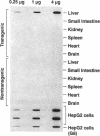Abstract
The B apolipoproteins, apo-B48 and apo-B100, are key structural proteins in those classes of lipoproteins considered to be atherogenic [e.g., chylomicron remnants, beta-VLDL, LDL, oxidized LDL, and Lp(a)]. Here we describe the development of transgenic mice expressing high levels of human apo-B48 and apo-B100. A 79.5-kb human genomic DNA fragment containing the entire human apo-B gene was isolated from a P1 bacteriophage library and microinjected into fertilized mouse eggs. 16 transgenic founders expressing human apo-B were generated, and the animals with the highest expression had plasma apo-B100 levels nearly as high as those of normolipidemic humans (approximately 50 mg/dl). The human apo-B100 in transgenic mouse plasma was present largely in lipoproteins of the LDL class as shown by agarose gel electrophoresis, chromatography on a Superose 6 column, and density gradient ultracentrifugation. When the human apo-B transgenic founders were crossed with transgenic mice expressing human apo(a), the offspring that expressed both transgenes had high plasma levels of human Lp(a). Both the human apo-B and Lp(a) transgenic mice will be valuable resources for studying apo-B metabolism and the role of apo-B and Lp(a) in atherosclerosis.
Full text
PDF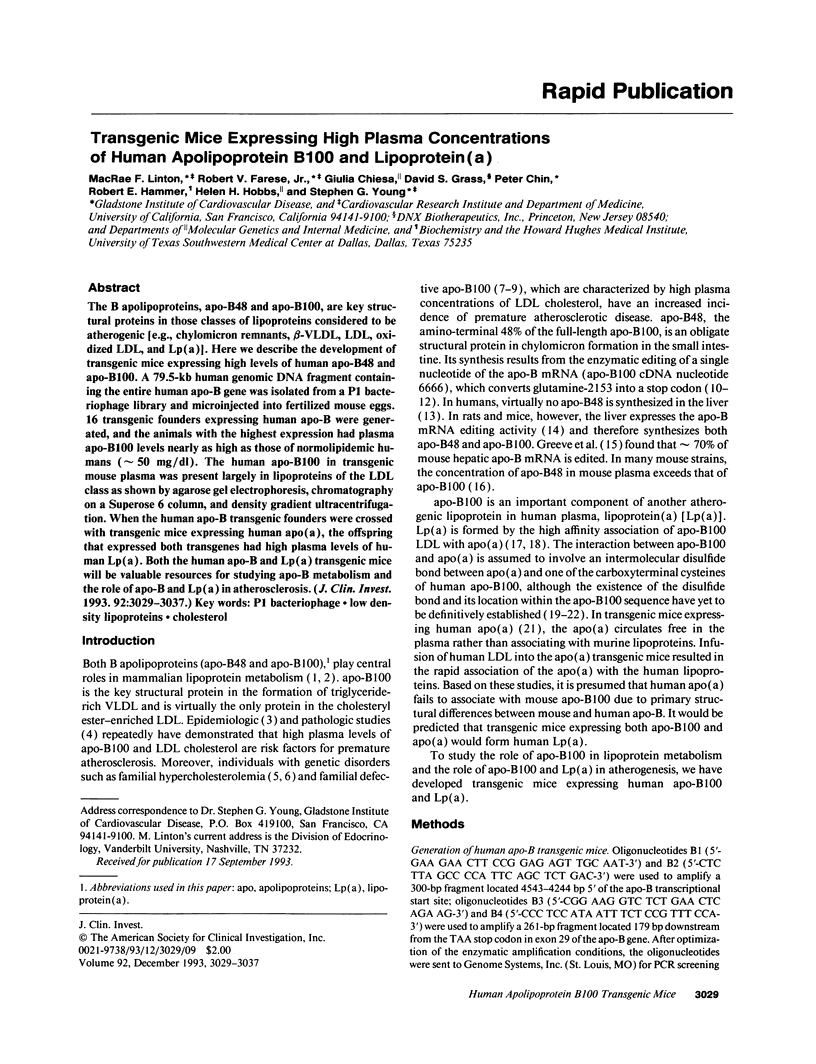

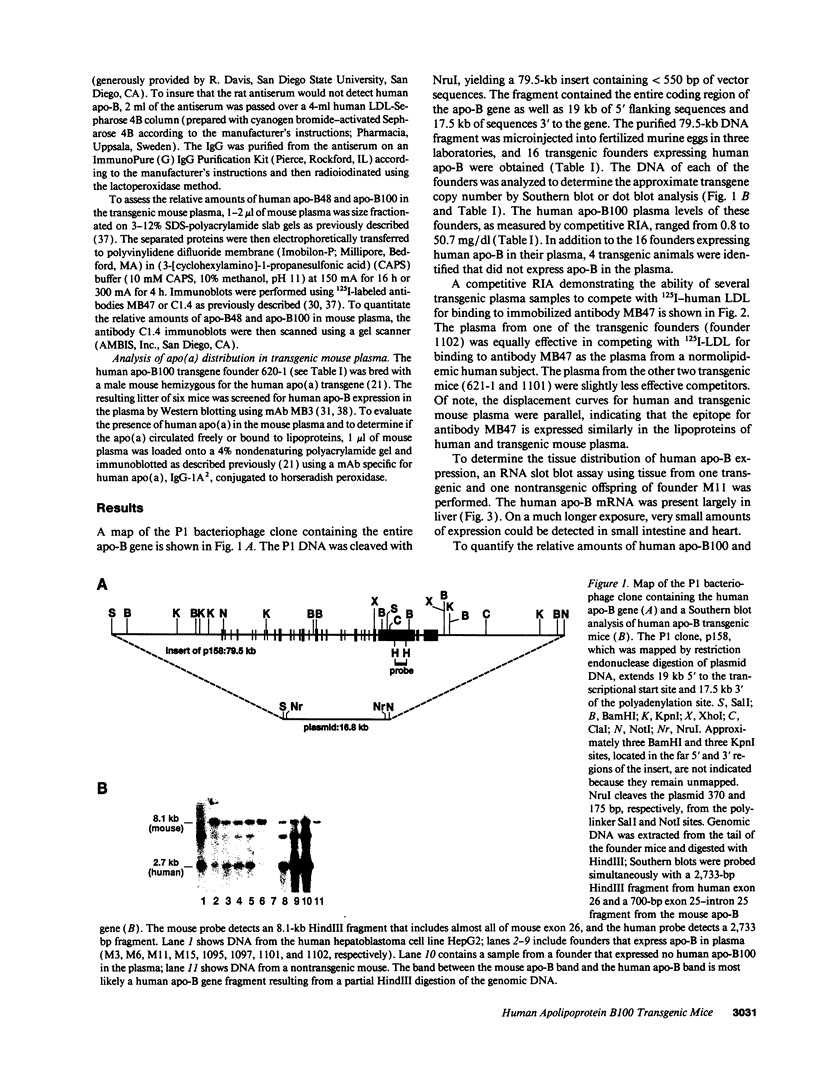
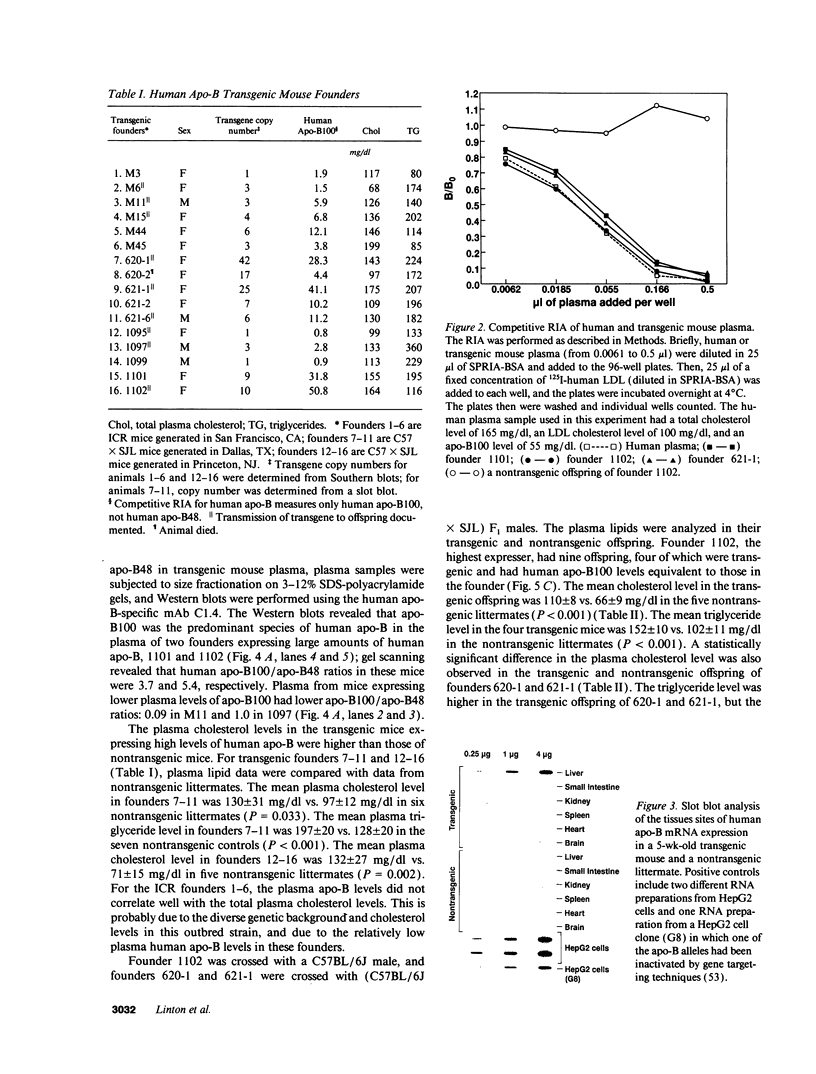
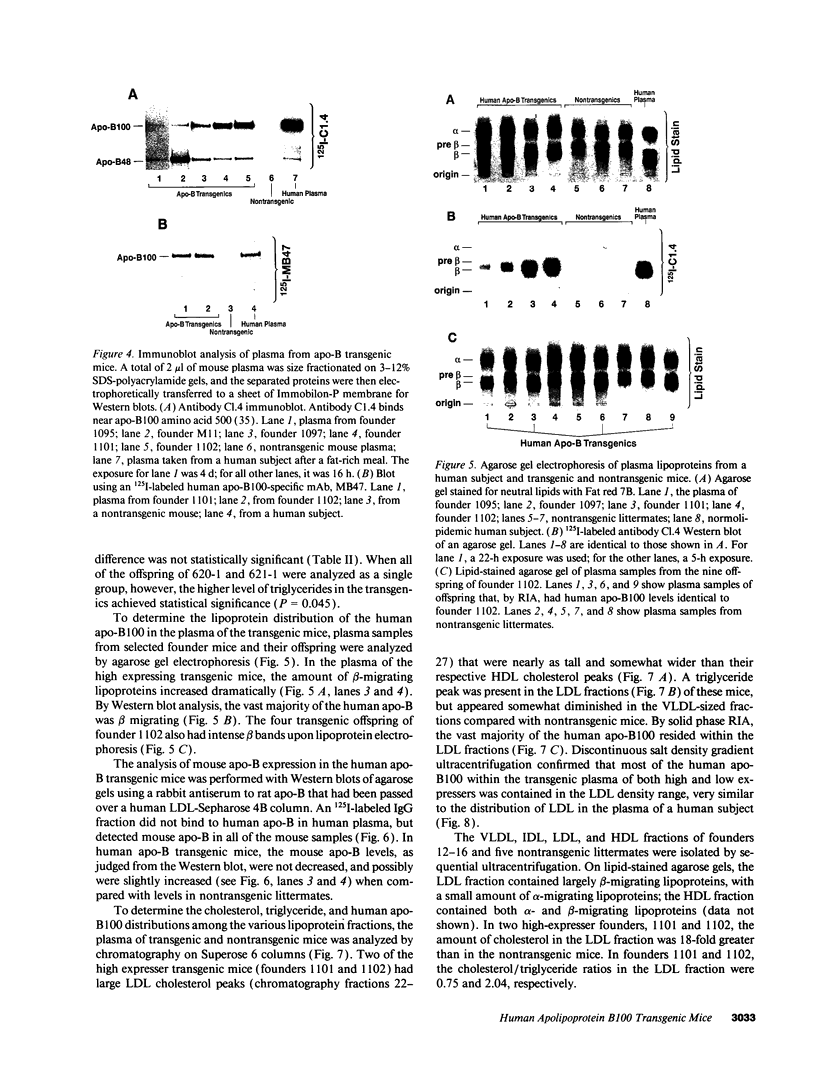
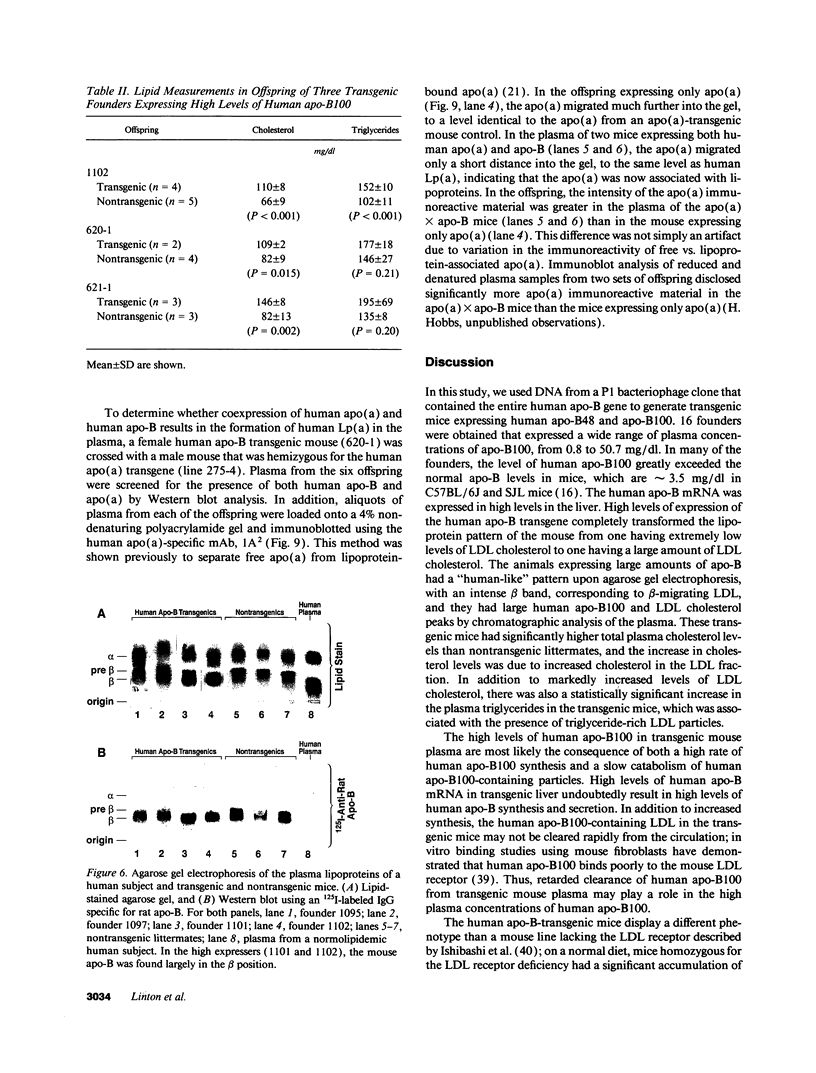
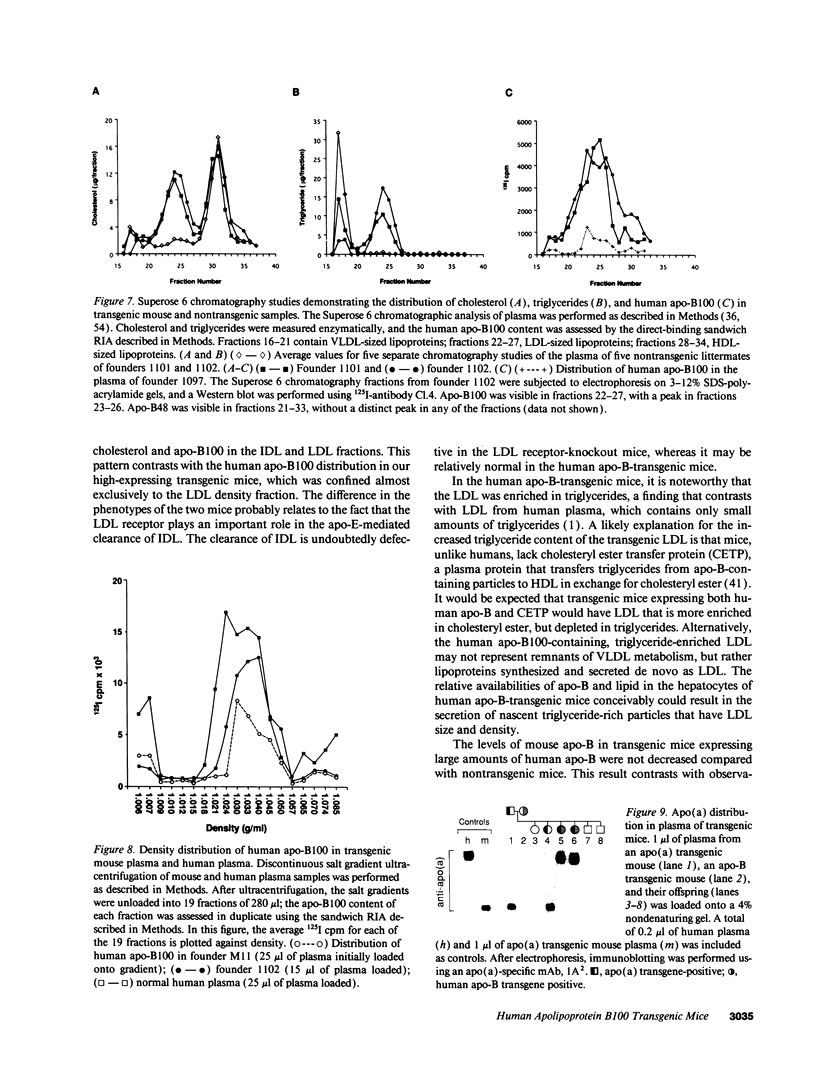
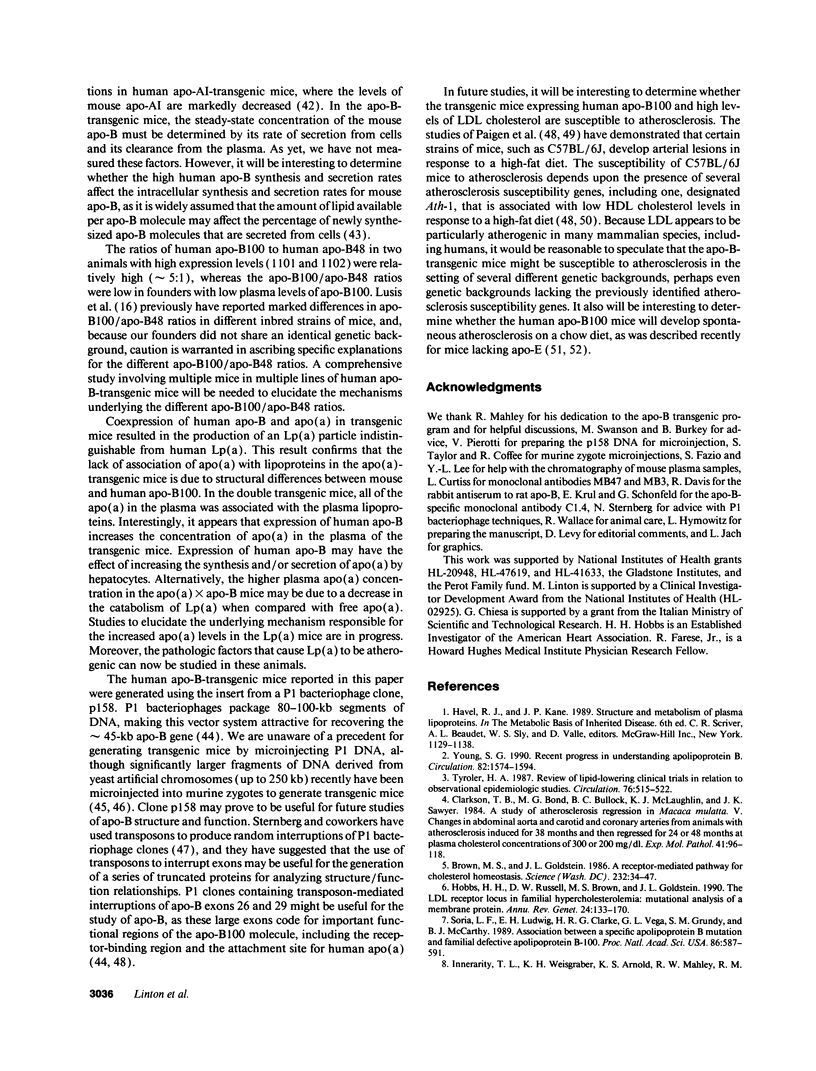
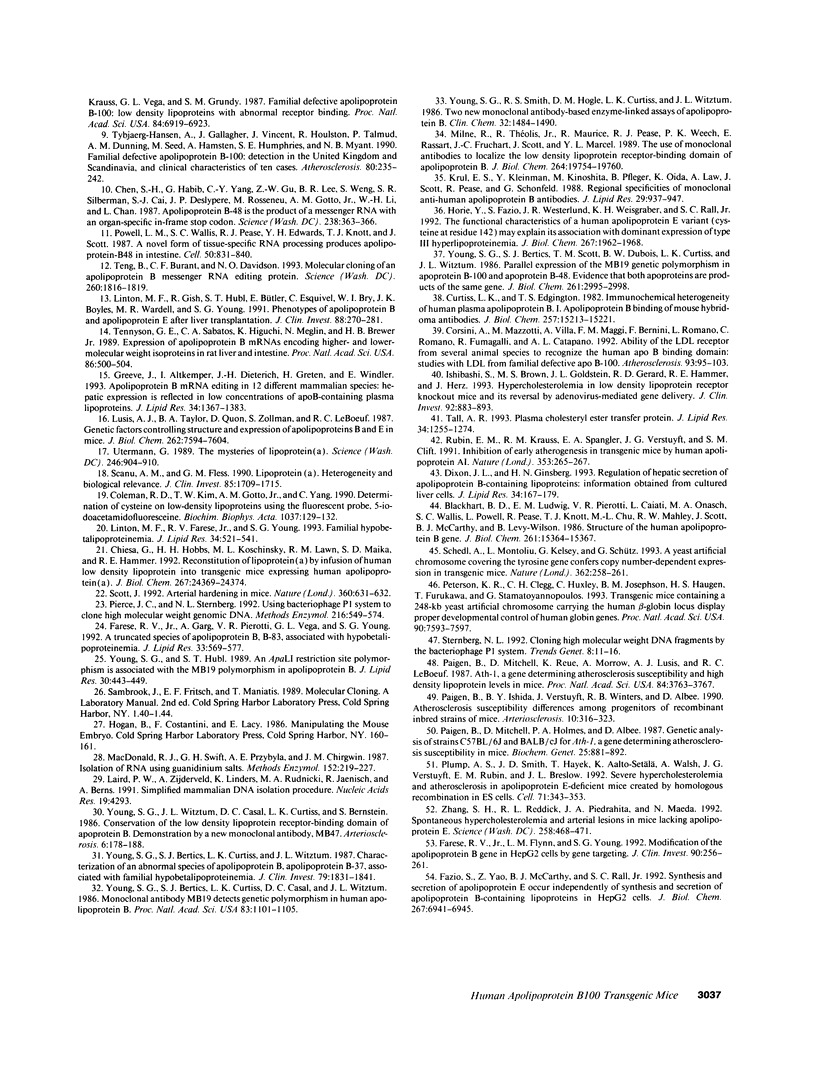
Images in this article
Selected References
These references are in PubMed. This may not be the complete list of references from this article.
- Blackhart B. D., Ludwig E. M., Pierotti V. R., Caiati L., Onasch M. A., Wallis S. C., Powell L., Pease R., Knott T. J., Chu M. L. Structure of the human apolipoprotein B gene. J Biol Chem. 1986 Nov 25;261(33):15364–15367. [PubMed] [Google Scholar]
- Brown M. S., Goldstein J. L. A receptor-mediated pathway for cholesterol homeostasis. Science. 1986 Apr 4;232(4746):34–47. doi: 10.1126/science.3513311. [DOI] [PubMed] [Google Scholar]
- Chen S. H., Habib G., Yang C. Y., Gu Z. W., Lee B. R., Weng S. A., Silberman S. R., Cai S. J., Deslypere J. P., Rosseneu M. Apolipoprotein B-48 is the product of a messenger RNA with an organ-specific in-frame stop codon. Science. 1987 Oct 16;238(4825):363–366. doi: 10.1126/science.3659919. [DOI] [PubMed] [Google Scholar]
- Chiesa G., Hobbs H. H., Koschinsky M. L., Lawn R. M., Maika S. D., Hammer R. E. Reconstitution of lipoprotein(a) by infusion of human low density lipoprotein into transgenic mice expressing human apolipoprotein(a). J Biol Chem. 1992 Dec 5;267(34):24369–24374. [PubMed] [Google Scholar]
- Clarkson T. B., Bond M. G., Bullock B. C., McLaughlin K. J., Sawyer J. K. A study of atherosclerosis regression in Macaca mulatta. V. Changes in abdominal aorta and carotid and coronary arteries from animals with atherosclerosis induced for 38 months and then regressed for 24 or 48 months at plasma cholesterol concentrations of 300 or 200 mg/dl. Exp Mol Pathol. 1984 Aug;41(1):96–118. doi: 10.1016/0014-4800(84)90011-x. [DOI] [PubMed] [Google Scholar]
- Coleman R. D., Kim T. W., Gotto A. M., Jr, Yang C. Y. Determination of cysteine on low-density lipoproteins using the fluorescent probe, 5-iodoacetamidofluoresceine. Biochim Biophys Acta. 1990 Jan 19;1037(1):129–132. doi: 10.1016/0167-4838(90)90111-r. [DOI] [PubMed] [Google Scholar]
- Corsini A., Mazzotti M., Villa A., Maggi F. M., Bernini F., Romano L., Romano C., Fumagalli R., Catapano A. L. Ability of the LDL receptor from several animal species to recognize the human apo B binding domain: studies with LDL from familial defective apo B-100. Atherosclerosis. 1992 Mar;93(1-2):95–103. doi: 10.1016/0021-9150(92)90203-s. [DOI] [PubMed] [Google Scholar]
- Curtiss L. K., Edgington T. S. Immunochemical heterogeneity of human plasma apolipoprotein B. I. Apolipoprotein B binding of mouse hybridoma antibodies. J Biol Chem. 1982 Dec 25;257(24):15213–15221. [PubMed] [Google Scholar]
- Dixon J. L., Ginsberg H. N. Regulation of hepatic secretion of apolipoprotein B-containing lipoproteins: information obtained from cultured liver cells. J Lipid Res. 1993 Feb;34(2):167–179. [PubMed] [Google Scholar]
- Farese R. V., Jr, Flynn L. M., Young S. G. Modification of the apolipoprotein B gene in HepG2 cells by gene targeting. J Clin Invest. 1992 Jul;90(1):256–261. doi: 10.1172/JCI115845. [DOI] [PMC free article] [PubMed] [Google Scholar]
- Farese R. V., Jr, Garg A., Pierotti V. R., Vega G. L., Young S. G. A truncated species of apolipoprotein B, B-83, associated with hypobetalipoproteinemia. J Lipid Res. 1992 Apr;33(4):569–577. [PubMed] [Google Scholar]
- Fazio S., Yao Z., McCarthy B. J., Rall S. C., Jr Synthesis and secretion of apolipoprotein E occur independently of synthesis and secretion of apolipoprotein B-containing lipoproteins in HepG2 cells. J Biol Chem. 1992 Apr 5;267(10):6941–6945. [PubMed] [Google Scholar]
- Greeve J., Altkemper I., Dieterich J. H., Greten H., Windler E. Apolipoprotein B mRNA editing in 12 different mammalian species: hepatic expression is reflected in low concentrations of apoB-containing plasma lipoproteins. J Lipid Res. 1993 Aug;34(8):1367–1383. [PubMed] [Google Scholar]
- Hobbs H. H., Russell D. W., Brown M. S., Goldstein J. L. The LDL receptor locus in familial hypercholesterolemia: mutational analysis of a membrane protein. Annu Rev Genet. 1990;24:133–170. doi: 10.1146/annurev.ge.24.120190.001025. [DOI] [PubMed] [Google Scholar]
- Horie Y., Fazio S., Westerlund J. R., Weisgraber K. H., Rall S. C., Jr The functional characteristics of a human apolipoprotein E variant (cysteine at residue 142) may explain its association with dominant expression of type III hyperlipoproteinemia. J Biol Chem. 1992 Jan 25;267(3):1962–1968. [PubMed] [Google Scholar]
- Innerarity T. L., Weisgraber K. H., Arnold K. S., Mahley R. W., Krauss R. M., Vega G. L., Grundy S. M. Familial defective apolipoprotein B-100: low density lipoproteins with abnormal receptor binding. Proc Natl Acad Sci U S A. 1987 Oct;84(19):6919–6923. doi: 10.1073/pnas.84.19.6919. [DOI] [PMC free article] [PubMed] [Google Scholar]
- Ishibashi S., Brown M. S., Goldstein J. L., Gerard R. D., Hammer R. E., Herz J. Hypercholesterolemia in low density lipoprotein receptor knockout mice and its reversal by adenovirus-mediated gene delivery. J Clin Invest. 1993 Aug;92(2):883–893. doi: 10.1172/JCI116663. [DOI] [PMC free article] [PubMed] [Google Scholar]
- Krul E. S., Kleinman Y., Kinoshita M., Pfleger B., Oida K., Law A., Scott J., Pease R., Schonfeld G. Regional specificities of monoclonal anti-human apolipoprotein B antibodies. J Lipid Res. 1988 Jul;29(7):937–947. [PubMed] [Google Scholar]
- Laird P. W., Zijderveld A., Linders K., Rudnicki M. A., Jaenisch R., Berns A. Simplified mammalian DNA isolation procedure. Nucleic Acids Res. 1991 Aug 11;19(15):4293–4293. doi: 10.1093/nar/19.15.4293. [DOI] [PMC free article] [PubMed] [Google Scholar]
- Linton M. F., Farese R. V., Jr, Young S. G. Familial hypobetalipoproteinemia. J Lipid Res. 1993 Apr;34(4):521–541. [PubMed] [Google Scholar]
- Linton M. F., Gish R., Hubl S. T., Bütler E., Esquivel C., Bry W. I., Boyles J. K., Wardell M. R., Young S. G. Phenotypes of apolipoprotein B and apolipoprotein E after liver transplantation. J Clin Invest. 1991 Jul;88(1):270–281. doi: 10.1172/JCI115288. [DOI] [PMC free article] [PubMed] [Google Scholar]
- Lusis A. J., Taylor B. A., Quon D., Zollman S., LeBoeuf R. C. Genetic factors controlling structure and expression of apolipoproteins B and E in mice. J Biol Chem. 1987 Jun 5;262(16):7594–7604. [PubMed] [Google Scholar]
- MacDonald R. J., Swift G. H., Przybyla A. E., Chirgwin J. M. Isolation of RNA using guanidinium salts. Methods Enzymol. 1987;152:219–227. doi: 10.1016/0076-6879(87)52023-7. [DOI] [PubMed] [Google Scholar]
- Milne R., Théolis R., Jr, Maurice R., Pease R. J., Weech P. K., Rassart E., Fruchart J. C., Scott J., Marcel Y. L. The use of monoclonal antibodies to localize the low density lipoprotein receptor-binding domain of apolipoprotein B. J Biol Chem. 1989 Nov 25;264(33):19754–19760. [PubMed] [Google Scholar]
- Paigen B., Ishida B. Y., Verstuyft J., Winters R. B., Albee D. Atherosclerosis susceptibility differences among progenitors of recombinant inbred strains of mice. Arteriosclerosis. 1990 Mar-Apr;10(2):316–323. doi: 10.1161/01.atv.10.2.316. [DOI] [PubMed] [Google Scholar]
- Paigen B., Mitchell D., Holmes P. A., Albee D. Genetic analysis of strains C57BL/6J and BALB/cJ for Ath-1, a gene determining atherosclerosis susceptibility in mice. Biochem Genet. 1987 Dec;25(11-12):881–892. doi: 10.1007/BF00502607. [DOI] [PubMed] [Google Scholar]
- Paigen B., Mitchell D., Reue K., Morrow A., Lusis A. J., LeBoeuf R. C. Ath-1, a gene determining atherosclerosis susceptibility and high density lipoprotein levels in mice. Proc Natl Acad Sci U S A. 1987 Jun;84(11):3763–3767. doi: 10.1073/pnas.84.11.3763. [DOI] [PMC free article] [PubMed] [Google Scholar]
- Peterson K. R., Clegg C. H., Huxley C., Josephson B. M., Haugen H. S., Furukawa T., Stamatoyannopoulos G. Transgenic mice containing a 248-kb yeast artificial chromosome carrying the human beta-globin locus display proper developmental control of human globin genes. Proc Natl Acad Sci U S A. 1993 Aug 15;90(16):7593–7597. doi: 10.1073/pnas.90.16.7593. [DOI] [PMC free article] [PubMed] [Google Scholar]
- Pierce J. C., Sternberg N. L. Using bacteriophage P1 system to clone high molecular weight genomic DNA. Methods Enzymol. 1992;216:549–574. doi: 10.1016/0076-6879(92)16049-p. [DOI] [PubMed] [Google Scholar]
- Plump A. S., Smith J. D., Hayek T., Aalto-Setälä K., Walsh A., Verstuyft J. G., Rubin E. M., Breslow J. L. Severe hypercholesterolemia and atherosclerosis in apolipoprotein E-deficient mice created by homologous recombination in ES cells. Cell. 1992 Oct 16;71(2):343–353. doi: 10.1016/0092-8674(92)90362-g. [DOI] [PubMed] [Google Scholar]
- Powell L. M., Wallis S. C., Pease R. J., Edwards Y. H., Knott T. J., Scott J. A novel form of tissue-specific RNA processing produces apolipoprotein-B48 in intestine. Cell. 1987 Sep 11;50(6):831–840. doi: 10.1016/0092-8674(87)90510-1. [DOI] [PubMed] [Google Scholar]
- Rubin E. M., Krauss R. M., Spangler E. A., Verstuyft J. G., Clift S. M. Inhibition of early atherogenesis in transgenic mice by human apolipoprotein AI. Nature. 1991 Sep 19;353(6341):265–267. doi: 10.1038/353265a0. [DOI] [PubMed] [Google Scholar]
- Scanu A. M., Fless G. M. Lipoprotein (a). Heterogeneity and biological relevance. J Clin Invest. 1990 Jun;85(6):1709–1715. doi: 10.1172/JCI114625. [DOI] [PMC free article] [PubMed] [Google Scholar]
- Schedl A., Montoliu L., Kelsey G., Schütz G. A yeast artificial chromosome covering the tyrosinase gene confers copy number-dependent expression in transgenic mice. Nature. 1993 Mar 18;362(6417):258–261. doi: 10.1038/362258a0. [DOI] [PubMed] [Google Scholar]
- Scott J. Arterial hardening in mice. Nature. 1992 Dec 17;360(6405):631–632. doi: 10.1038/360631a0. [DOI] [PubMed] [Google Scholar]
- Soria L. F., Ludwig E. H., Clarke H. R., Vega G. L., Grundy S. M., McCarthy B. J. Association between a specific apolipoprotein B mutation and familial defective apolipoprotein B-100. Proc Natl Acad Sci U S A. 1989 Jan;86(2):587–591. doi: 10.1073/pnas.86.2.587. [DOI] [PMC free article] [PubMed] [Google Scholar]
- Sternberg N. L. Cloning high molecular weight DNA fragments by the bacteriophage P1 system. Trends Genet. 1992 Jan;8(1):11–16. doi: 10.1016/0168-9525(92)90018-y. [DOI] [PubMed] [Google Scholar]
- Tall A. R. Plasma cholesteryl ester transfer protein. J Lipid Res. 1993 Aug;34(8):1255–1274. [PubMed] [Google Scholar]
- Teng B., Burant C. F., Davidson N. O. Molecular cloning of an apolipoprotein B messenger RNA editing protein. Science. 1993 Jun 18;260(5115):1816–1819. doi: 10.1126/science.8511591. [DOI] [PubMed] [Google Scholar]
- Tennyson G. E., Sabatos C. A., Higuchi K., Meglin N., Brewer H. B., Jr Expression of apolipoprotein B mRNAs encoding higher- and lower-molecular weight isoproteins in rat liver and intestine. Proc Natl Acad Sci U S A. 1989 Jan;86(2):500–504. doi: 10.1073/pnas.86.2.500. [DOI] [PMC free article] [PubMed] [Google Scholar]
- Tybjaerg-Hansen A., Gallagher J., Vincent J., Houlston R., Talmud P., Dunning A. M., Seed M., Hamsten A., Humphries S. E., Myant N. B. Familial defective apolipoprotein B-100: detection in the United Kingdom and Scandinavia, and clinical characteristics of ten cases. Atherosclerosis. 1990 Jan;80(3):235–242. doi: 10.1016/0021-9150(90)90031-d. [DOI] [PubMed] [Google Scholar]
- Tyroler H. A. Review of lipid-lowering clinical trials in relation to observational epidemiologic studies. Circulation. 1987 Sep;76(3):515–522. doi: 10.1161/01.cir.76.3.515. [DOI] [PubMed] [Google Scholar]
- Utermann G. The mysteries of lipoprotein(a). Science. 1989 Nov 17;246(4932):904–910. doi: 10.1126/science.2530631. [DOI] [PubMed] [Google Scholar]
- Young S. G., Bertics S. J., Curtiss L. K., Casal D. C., Witztum J. L. Monoclonal antibody MB19 detects genetic polymorphism in human apolipoprotein B. Proc Natl Acad Sci U S A. 1986 Feb;83(4):1101–1105. doi: 10.1073/pnas.83.4.1101. [DOI] [PMC free article] [PubMed] [Google Scholar]
- Young S. G., Bertics S. J., Curtiss L. K., Witztum J. L. Characterization of an abnormal species of apolipoprotein B, apolipoprotein B-37, associated with familial hypobetalipoproteinemia. J Clin Invest. 1987 Jun;79(6):1831–1841. doi: 10.1172/JCI113025. [DOI] [PMC free article] [PubMed] [Google Scholar]
- Young S. G., Bertics S. J., Scott T. M., Dubois B. W., Curtiss L. K., Witztum J. L. Parallel expression of the MB19 genetic polymorphism in apoprotein B-100 and apoprotein B-48. Evidence that both apoproteins are products of the same gene. J Biol Chem. 1986 Mar 5;261(7):2995–2998. [PubMed] [Google Scholar]
- Young S. G., Hubl S. T. An ApaLI restriction site polymorphism is associated with the MB19 polymorphism in apolipoprotein B. J Lipid Res. 1989 Mar;30(3):443–449. [PubMed] [Google Scholar]
- Young S. G. Recent progress in understanding apolipoprotein B. Circulation. 1990 Nov;82(5):1574–1594. doi: 10.1161/01.cir.82.5.1574. [DOI] [PubMed] [Google Scholar]
- Young S. G., Smith R. S., Hogle D. M., Curtiss L. K., Witztum J. L. Two new monoclonal antibody-based enzyme-linked assays of apolipoprotein B. Clin Chem. 1986 Aug;32(8):1484–1490. [PubMed] [Google Scholar]
- Young S. G., Witztum J. L., Casal D. C., Curtiss L. K., Bernstein S. Conservation of the low density lipoprotein receptor-binding domain of apoprotein B. Demonstration by a new monoclonal antibody, MB47. Arteriosclerosis. 1986 Mar-Apr;6(2):178–188. doi: 10.1161/01.atv.6.2.178. [DOI] [PubMed] [Google Scholar]
- Zhang S. H., Reddick R. L., Piedrahita J. A., Maeda N. Spontaneous hypercholesterolemia and arterial lesions in mice lacking apolipoprotein E. Science. 1992 Oct 16;258(5081):468–471. doi: 10.1126/science.1411543. [DOI] [PubMed] [Google Scholar]




